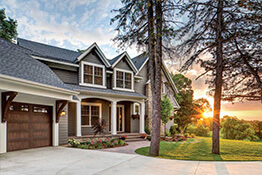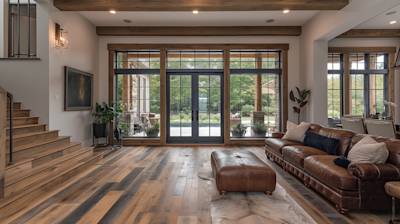Brickmould is an integral part of any home but is often overlooked by many. This unique finishing detail adds a touch of sophistication and elegance to your doorway or window, serving both functional and aesthetic purposes. Understanding what it is, its functions, the various types available, as well as how to install and maintain it, can significantly enhance your home's curb appeal.
The Basics: What is Brickmould?
Brickmould, also known as brick molding or brick mould, is a type of exterior trim that wraps around your doors and windows. It's typically made of wood, but advancements in materials and technology have led to the development of vinyl and composite variations, offering homeowners a broad spectrum of choices when it comes to selecting the perfect brickmould for their homes.
Functionality of Brickmould
Sealing and Insulation
One of the fundamental functions of brickmould is to provide an efficient seal around your windows and doors. This helps to keep out dirt, moisture, drafts, insects, and other exterior elements, thereby protecting your home's interiors and enhancing insulation.
Elegance and Style
Aside from functionality, brickmould adds architectural detail and a dash of elegance to your home's exteriors. With different designs and colors available, homeowners can easily match or complement their existing exterior finishes for a more cohesive or contrasting look.
Different Types of Brickmould
Wooden Brickmould
Wooden brickmould is perhaps the most traditional type, known for its timeless elegance and natural finish.
-
Pros: Offers a natural wood finish and excellent insulation properties.
-
Cons: Can warp, rot, and be prone to insect damage.
Vinyl Brickmould
Vinyl brickmould is modern and arguably the most durable. It's resistant to rotting, warping, insect damage, and extreme weather conditions.
-
Pros: Low maintenance, durable, and available in multiple colors.
-
Cons: May not offer the same natural finish as wood.
Composite Brickmould
Composite brickmould is a mixture of wood and plastic. This type combines the aesthetics of wood with the durability of plastic.
-
Pros: Combines the benefits of both wood and vinyl. It's durable and aesthetically pleasing.
-
Cons: May be more expensive than other types.
Brickmould Installation and Maintenance
Brickmould installation requires precision and craftsmanship. It can be done as a DIY project, but hiring a professional might be the best route if you're not experienced with this type of work. Maintenance varies based on brickmould material, with wood requiring more regular care than its vinyl or composite counterparts.
Installation
Installing brickmould usually involves precise measurements, cutting to the correct lengths, and securing to the door or window framing with nails or screws. It's essential to verify that your brickmould is level and fits perfectly around your doors or windows before securing it into place.
Maintenance
Maintenance for brickmould typically involves regular cleaning and periodic painting or staining (for wooden types) to prolong its life and retain its aesthetic appeal. Composite and vinyl brickmoulds are generally low maintenance, requiring only occasional cleaning.
Understanding what brickmould is and appreciating its various types and functions can be an asset for any homeowner. Whether you prefer a traditional wooden look, the strength and versatility of vinyl, or the best of both worlds with composite, brickmould contributes significantly to enhancing your home's aesthetic and functional features. From installation to maintenance, now you're equipped with the knowledge you need to manage this essential part of your home's exterior.
Frequently Asked Questions about Brickmould
What are the typical dimensions of brickmould?
Brickmould typically comes in standard sizes. The most common dimensions are 2 inches deep and 1 1/4 inches wide. However, it can be made of various widths, ranging typically from 1 inch to 2 inches. Remember, these parameters can vary depending on the specific needs of your construction project or specific requirements of the house's architectural design.
What materials are commonly used in making brickmould?
Brickmould can be made from various materials. These include traditional wood, PVC plastic, and composite materials. Recently, due to improved durability, minimal maintenance, and resistance to weather, PVC and composite materials have become popular choices for brickmoulding.
When should I consider replacing brickmould?
If your brickmould shows signs of wear, damage, rot, or decay, it's probably time to consider replacing it. Other reasons might include if you're doing a home renovation or if you want to upgrade for better weather resistance or aesthetics. It's always best to regularly check to ensure that your brickmould is in good condition as this can help prevent heat loss and protect your home from pests and weather damage.
Can I install brickmould myself?
Yes, installing brickmould can be a DIY project, but it requires some knowledge about carpentry tools, accurate measurement, and cutting. If you're not confident with your skills, it's recommended to hire a professional to undertake the task to ensure it's done properly and securely.
How do I maintain my brickmould?
Maintenance of brickmould largely depends on the material it is made of. For instance, wooden brickmould may need periodic painting or staining to keep it looking good and to protect it from the elements. However, if your brickmould is made from PVC or composite materials, it's essentially maintenance-free aside from needing occasional cleaning.
Can I paint my brickmould?
Yes, you can paint brickmould. If it's made of wood or composite materials, it can easily be painted to match the color scheme of your house or to provide a contrasting pop of color. For PVC brickmould, while it can be painted, it doesn't necessarily need to be because it's manufactured in various colors.
Can brickmould be used on doors as well as windows?
Definitely! While widely used for windows, brickmould can also be a great addition to doors. It not only enhances the overall appearance but also serves as a crucial component in sealing the door frame, protecting it from weather and other external conditions.
How does brickmould affect the overall look of my house?
The addition of brickmoulding can significantly enhance the aesthetic appeal of your house. By providing a seamless transition between the wall and the window or doors, brickmould adds a finished look, giving your home a stylish and sophisticated appearance.
Is it expensive to add brickmould to my house?
The cost of adding brickmould varies greatly depending on the material used, the size, the amount needed, and whether you'll be installing it yourself or hiring a professional. However, as a general ballpark, you can expect it to be a cost-effective way to enhance the look of your home while adding an extra layer of item protection.
Pros of Brickmould
Durability
Brickmould is known for its exceptional durability. Here's why:
-
One of the significant advantages of brickmould is its incredible sturdiness. Crafted from high-quality materials, brickmould can withstand harsh weather conditions, resisting wind, rain, and snow without warping or cracking.
-
Brickmould is highly resistant to rot and decay. This is especially true when treated or engineered with water-resistant properties, making it an excellent option for maintaining the aesthetics of your exterior over time.
-
Termites and other destructive pests are unlikely to afflict brickmould, contributing further to its long lifespan. Thus, this significantly reduces maintenance and replacement costs associated with other types of moulding.
Visual Appeal
Brickmould can enhance the aesthetic appeal of building exteriors. Key points include:
-
Brickmould can highlight the transition between the wall and the door or windows, creating a distinct, visually interesting boundary that contributes to a more polished and finished look.
-
Available in various designs and finishes, brickmould can complement almost any architectural style, from traditional classics to modern minimalism.
-
Brickmould can be painted to match or contrast with your exterior paint scheme, allowing homeowners to customize their property’s look to their exact preferences.
Increased Property Value
With its practical and aesthetic benefits, brickmould can contribute to increasing property value. This is why:
-
Brickmould conveys an impression of quality and attention to detail. This can be influential when valuing the property and can be a distinct selling point if you plan to sell your property in the future.
-
Brickmould helps maintain the structural integrity of the door or window framework, which can also enhance property value as potential buyers appreciate homes that require minimal repair and maintenance.
Cons of Brickmould
Cost
One of the potential downsides of brickmould is associated cost, which can be higher compared to other moulding options. Here are the reasons:
-
Due to the high-quality materials used and the benefits offered, brickmould is typically priced higher than other moulding types.
-
Installation costs could also be more than standard moulding. The installation procedure can be tricky, requiring professional handling, especially with larger windows and doors.
Higher Maintenance
Despite its durability, brickmould still requires occasional maintenance to retain its aesthetics. Aspects to consider include:
-
Brickmould may need periodic painting to maintain its appearance, especially when not made from rot-resistant material.
-
Despite its resistance to pests and decay, brickmould should be regularly checked for any signs of damage to prevent issues from worsening over time.
Limited Flexibility
Brickmould may not be suitable for all construction or architectural styles. This limitation includes:
-
While brickmould suits many architectural styles, it may not blend with every design. In ultra-modern or minimalist designs, the detailed profile of brickmould may appear too traditional.
-
While brickmould can be painted to suit your preferred color scheme, the shape and design are less flexible, potentially limiting customization options.
Summary
So, brickmould plays an outstanding role in the world of construction. This integral part of door and window framing not only contributes to a seamless design but also provides insulation and protection from varying weather conditions. The beauty of brickmould is in its versatility, available in a multitude of materials like wood, PVC, or composite, there's something to suit every taste and need.
We often overlook the significance of small things, and brickmould is one of those. Even though brickmould might seem insignificant in the grand scheme of building design, it's quite vital. From adding aesthetic appeal and charm to exteriors to reducing the need for maintenance when using sustainable materials like PVC, brickmould holds its weight in gold.
What's clear is the ongoing importance of brickmould, from traditional homes to modern builds. Born from practicality, its role has evolved to highlight style and elegance while retaining its original purpose. So, whether you're renovating, building new, or just savvy about construction details, the humble brickmould merits a closer look and appreciation.
About US Quality Construction of Columbus
Welcome to US Quality Construction of Columbus, your trusted partner in the heart of Columbus, OH! With our years of experience in the construction industry, we've been committed to building not just high-quality structures but also robust client relationships grounded on loyalty and integrity. Our team is full of skilled professionals ready to bring your dream project to life. So whether it's your dream home, commercial building or any other kind of construction undertaking, with us, you're in safe hands.
Tags: brickmould, home improvement, exterior design,









